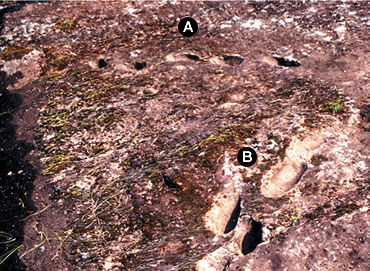Oldest human footprints found on volcano
12 March 2003
 NewScientists.com
News Service ---Three primitive humans who scrambled down a volcano's
slopes more than 325,000 years ago left their footprints fossilised in
volcanic ash.
NewScientists.com
News Service ---Three primitive humans who scrambled down a volcano's
slopes more than 325,000 years ago left their footprints fossilised in
volcanic ash.
If the ages of the trails are confirmed, they could be the earliest known
footprints of our Homo ancestors.
Paolo Mietto of Padua University and his colleagues examined three tracks of footprints on the Roccamonfina volcano in southern Italy, known to locals as "devils' trails." "Because they occur in volcanic rock, they have always been considered supernatural," says Mietto. The scientists say the footprints are fossilised in ash deposited by an eruption that has already been dated as 385,000 to 325,000 years old by radiometric techniques.
One person left a track of 27 footprints in a zig-zag pattern, which probably made descent of the steep slope easier. Another track of 19 prints shows a gentle curve, but there are occasional palm-prints where the walker put a hand on the ground probably to avoid slipping.
A third track of 10 evenly spaced prints forms a straight line. There are also two animal tracks, possibly made by big dogs or wolves.
Short order
The human footprints are about 20 centimetres long and 10 cm wide. Using
the average foot length to height ratio of 15 per cent, this suggests
the people who made the tracks were only about 135 cm tall (4' 5").
The footprints are just 20 centimetres long (Image: Paolo Mietto and Marco
Avanzini)
If the ages of the tracks are confirmed, the footprints could have been made by Homo heidelbergensis, thought to have evolved more than 600,000 years ago and migrated to Europe from Africa. "In my view, the [footprint makers] would have been the ancestors of Neanderthals," says Chris Stringer of the Natural History Museum in London.
Many anthropologists believe H. heidelbergensis evolved into Neanderthals in Europe, but into modern humans, H. sapiens, in Africa. However, there is no consensus about the migration patterns of our primitive ancestors.
In the Steps of LucyThe Italian fossils are much younger than the oldest known hominid footprints - those near Olduvai Gorge in Tanzania are more than 3.7 million years old. They were probably made by two individuals of the distant ancestral species Australopithecus afarensis, of which the famous fossil skeleton Lucy was a member. However, the devils' trails may be the earliest known footprints of a Homo species, which some consider to be the first true humans.
Leslie Aiello, an anthropologist at University College London, thinks the people who left the footprints seem surprisingly small for H. heidelbergensis adults.
Boxgrove man, another H. heidelbergenesis individual whose tibia was found in England in 1993, seems to have been more than 180 cm tall (six feet). The Italian footprints could have been made by children, suggests Aiello.
Journal reference:
Nature (vol 422, p 133)
Hazel Muir
Portions of
this website are reprinted under the Fair Use Doctrine of International
Copyright Law as educational material without benefit of financial gain.
http://www4.law.cornell.edu/uscode/17/107.html
This proviso is applicable throughout the entire website.